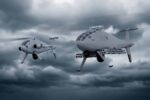At DSEI 2025 in London, the RCV Pioneer unmanned ground vehicle (UGV) was unveiled as a next-generation platform for robotic counter-mine and route clearance operations. Developed to address the growing demand for safer and more efficient explosive ordnance disposal (EOD) capabilities in contested environments, the system exemplifies how robotics are reshaping modern battlefield mobility support.
RCV Pioneer Overview and Design Philosophy
The RCV Pioneer is a tracked unmanned ground vehicle designed specifically for engineering support roles such as mine detection, route clearance, and improvised explosive device (IED) neutralization. The platform reflects a modular architecture that allows it to integrate various payloads depending on mission requirements—ranging from ground-penetrating radar (GPR) systems to manipulator arms and disruptors.
While not officially confirmed by the manufacturer at DSEI 2025, open-source analysis suggests that Milrem Robotics—known for its THeMIS UGV—may be involved or have influenced the design. The chassis bears resemblance to other NATO-standard UGVs with low-profile armored hulls optimized for blast resistance.
Key features include:
- Tracked mobility system with hybrid-electric propulsion
- Payload capacity estimated at ~750 kg
- Autonomous navigation with GPS-denied capability via LiDAR/EO fusion
- Integrated control via secure C2 link with fallback manual override
Counter-Mine Payload Integration
The centerpiece of the RCV Pioneer’s demonstration at DSEI was its integration of a multi-sensor counter-mine suite. This included:
- A forward-mounted GPR array capable of detecting buried metallic and non-metallic mines
- An articulated robotic arm equipped with a disruptor module for IED neutralization
- An EO/IR camera suite enabling remote visual inspection under armor protection
This payload combination enables not only passive detection but also active intervention without exposing human operators to danger. According to company representatives at DSEI 2025, the system can autonomously scan road segments up to several hundred meters per hour depending on terrain complexity while maintaining high fidelity in subsurface mapping.
C4ISR Integration and Remote Control Capabilities
The RCV Pioneer supports integration into broader C4ISR networks through encrypted data links compatible with NATO STANAG protocols. Operators can control the UGV from mobile command posts or armored vehicles using ruggedized tablets or control stations. The system supports both teleoperation and semi-autonomous modes including waypoint navigation and obstacle avoidance.
For contested electromagnetic environments where GNSS signals may be jammed or spoofed—a common threat in peer conflicts—the platform relies on inertial navigation systems (INS), visual odometry using EO/IR sensors, and LiDAR-based SLAM (Simultaneous Localization And Mapping). This ensures continued operability even under EW attack conditions.
Tactical Use Cases: From Route Clearance to Urban EOD Missions
The RCV Pioneer is tailored for multiple operational scenarios:
- Route Clearance: Leading convoys through suspected minefields or IED zones without risking manned vehicles.
- EOD Support: Remote disruption of IEDs in urban or rural settings where civilian presence complicates manual intervention.
- Combat Engineering: Supporting breaching operations by clearing safe lanes through minefields ahead of mechanized assaults.
The ability to operate autonomously or under remote supervision makes it especially valuable in high-risk environments such as Ukraine’s heavily mined frontlines or potential NATO expeditionary deployments where rapid mobility restoration is critical.
Industry Context and Future Development Pathways
The unveiling of the RCV Pioneer comes amid growing investment across NATO countries into uncrewed engineering systems. Programs like the UK’s Project Theseus and US Army’s Robotic Combat Vehicle initiatives underscore this trend toward robotic augmentation of traditionally manned combat support roles.
No formal procurement announcements were made at DSEI regarding the RCV Pioneer; however, discussions with military representatives indicate interest from several European armed forces seeking scalable counter-mine solutions that reduce personnel exposure while maintaining tempo during maneuver operations.
If adopted into service, future iterations may include enhanced autonomy via AI-driven target recognition algorithms or swarm coordination features allowing multiple UGVs to operate collaboratively across wider areas. Integration with aerial ISR assets such as tethered drones could further expand situational awareness during demining missions.
Conclusion: Robotics Advancing Battlefield Mobility Safety
The RCV Pioneer represents a significant step forward in applying robotics to one of land warfare’s most dangerous tasks—mine clearance. Its modularity, sensor fusion capabilities, and C4ISR connectivity make it a promising candidate for future engineer corps modernization programs across NATO-aligned forces. As threats from mines and IEDs persist globally—from Eastern Europe to Africa—the demand for such robotic solutions will likely continue accelerating beyond DSEI 2025.









